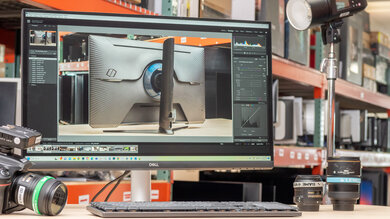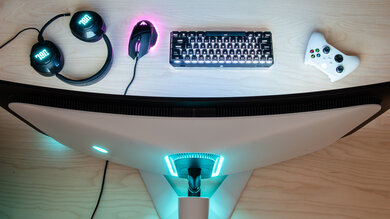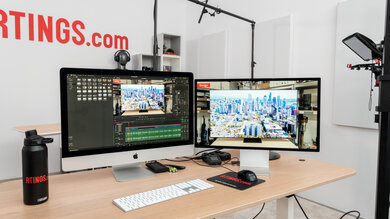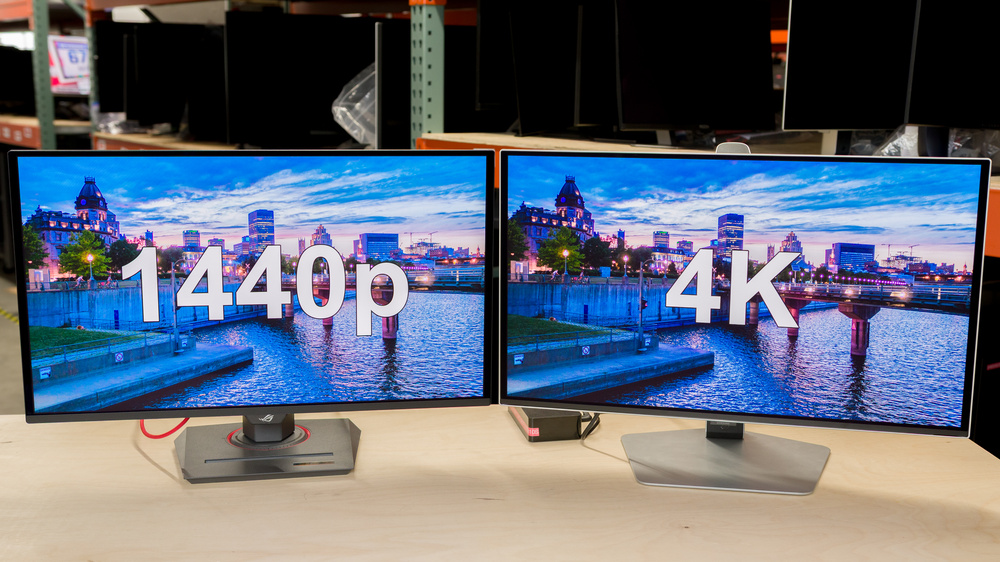Unless you're a PC gamer, choosing between 1440p vs 4k is easy; 4k is the better option. However, if you're a PC gamer, things are a bit more complicated, as the table below shows:
| Usage | 1440p | 4k |
|---|---|---|
| Productivity | Good | Best |
| Editing | Good | Best |
| PC Gaming | Best For Most PCs and Competitive Gamers | Best For Single-Player Games On High-End PCs |
| Console Gaming | Great | Best |
| Mixed Usage | Great | Best |
In this 4k vs 1440p article, we'll look in detail at which resolution is best for a given usage, including mixed usage scenarios. However, if you already know what resolution you want to use, take a look at our recommendations for the best 1440p monitors and the best 4k monitors.
Technical Details On Resolutions
Below is a summary of the technical differences between 1440p and 4k. This can give you a better idea of what to expect at each resolution, including things such as cost, common screen sizes, and marketing names.
| Resolution |
1440p 2560x1440 |
4k 3840x2160 |
|---|---|---|
| Horizontal Pixels | 2560 | 3840 |
| Vertical Pixels | 1440 | 2160 |
| Total Pixels | 3,686,400 | 8,294,400 |
| Marketing Names | 2k, Quad HD, QHD | 2160p, Ultra HD, UHD |
| Common Screen Sizes | 25 to 32 inches | 27 to 48 inches |
| Cost | Low to High | Medium to High |
| Image Detail | Better | Superb |
| Optimal Uses | Gaming Multimedia Productivity |
Gaming Multimedia Productivity Content Creation |
Productivity

Apart from cost, there's no downside to getting a 4k monitor for productivity tasks. 4k monitors display sharper text and have a more detailed image. If a 4k display is within your budget and is available in the size you want, we recommend this resolution for productivity.
That said, if a 4k display is outside your budget or it's not widely available in the size you want (such as 24 inches), many 1440p displays still have good text clarity if they're 24 to 27 inches. Overall, a 1440p monitor can provide a solid productivity experience, and you'll likely still be happy with a 27-inch 1440p display, but a 4k monitor is worth the extra money if you can afford it. If you want some help choosing the best productivity monitor, check out our best work monitors article.
Editing

A 4k monitor is the best choice for most editors. If you're doing video editing, you may want to release 4k content. If so, it's important to be able to review your video at that resolution. A 4k monitor also lets you see more detail when you're editing, even if you don't have your video filling the screen. And while a 1440p monitor can work quite well for producing content at that resolution or lower, it limits your options if you decide to start releasing 4k content in the future.
If you're editing photos, a 4k display provides numerous advantages. It displays images with more detail during editing, and if you're looking through sets of photos, each thumbnail will have more detail. For more information on finding the best editing monitor for you, take a look at the best monitors for video editing and the best monitors for photo editing.
Gaming

Gaming is one of the most challenging tasks for your computer, and it pushes your graphics card to its limit. Every pixel your monitor displays has to be rendered by your computer, so higher resolutions require your computer to render more pixels. At 4k, you need to render 8.3 million pixels in each frame, compared to just 3.7 million at 1440p. This means you need to game at a resolution your computer can handle, or games won't feel smooth and responsive. To help you find the best monitor, check out the best 4k gaming monitors and the best 1440p gaming monitors.
Low-End PCs
Low-end PCs (such as those without discrete graphics cards) work better at 1080p than 1440p or 4k for gaming. Far fewer pixels need to be rendered at 1080p compared to 1440p or 4k, so you generally get higher frame rates and a more responsive feel at that resolution. However, both 4k and 1440p monitors can be used at lower resolutions, like 1080p. As a result, if you're planning to use your computer for other tasks, like productivity or editing, get the right resolution for those other tasks and then use your monitor at whatever resolution you need to get a good frame rate. For more information about 1080p, take a look at our 1080p vs 1440p comparison article.
Mid-Range PCs
Mid-range PCs (such as those with an NVIDIA GeForce RTX 5060 graphics card) normally perform best at 1440p. These computers have more computing power than low-end PCs and can get good frame rates at 1440p. However, 4k is usually too much for these computers. There are significantly more pixels to render in each frame, so far more computing power and graphics card memory are needed. As a result, 1440p is the best resolution for most gamers with mid-range PCs, as you get a reasonably detailed image and a fairly responsive feel.
High-End PCs
High-end PCs (such as those with an NVIDIA GeForce RTX 5080 graphics card) can provide good performance at 4k. However, that doesn't necessarily mean you should get a 4k monitor. Gaming at 1440p with a high-end PC results in exceptionally high frame rates. If you primarily play competitive games, you may prefer gaming at 1440p instead of 4k because you'll usually have higher frame rates, which creates a more responsive feel. If this is the case, then you're better off getting a high-end 1440p display, as 1440p monitors are available at higher refresh rates than 4k monitors, so they can feel more responsive.
However, if you play primarily single-player games or games where extreme responsiveness isn't needed, a 4k monitor provides a more detailed, immersive experience. Also, if you're using your computer for more than just gaming, you also benefit from a 4k display, as you get sharper text and more detail for productivity, editing, and video watching.
Console Gaming
Consoles are designed to work well with 4k TVs, so they also work extremely well with 4k monitors. That said, 1440p monitors work with all consoles, even if they don't look as detailed with some games. The Xbox can only use HDR at 4k, though some 1440p monitors can downscale a 4k signal. For more information on monitors and consoles, check out the best monitors for the PS5/PS5 Pro, the Xbox Series X, the Xbox Series S, and the Nintendo Switch 2.
Mixed Usage

Many people use monitors for a mix of productivity, editing, and gaming. A 4k monitor is generally a better choice for mixed usage than a 1440p display, as you'll get sharper text and a more detailed image with 4k, and you can always use a 4k monitor at a lower resolution while gaming. That said, most 27-inch 1440p displays have decent or good text clarity, and if you'd rather use a 1440p monitor for cost or other reasons, it still works well for mixed usage.
Quite a few gaming monitors are excellent for productivity, though very few productivity monitors are good for fast-paced gaming. As a result, if you plan to play fast-paced games with your monitor, we recommend looking for a gaming monitor that performs well for productivity tasks. It's very uncommon to find an office monitor that works well for fast-paced gaming.
Frequently Asked Questions
Question: Will there be higher resolutions in the future?
Answer: Higher resolutions, such as 5k and 8k, are currently available. However, while there are a number of great 5k monitors, there are a very limited number of 8k displays, like the Dell UP3218K. The improvement in text clarity with an 8k display over a 4k display is noticeable, but not that significant at regular viewing distances. Additionally, 8k monitors require a computer to render four times as many pixels as 4k displays. 8k monitors also require more power to operate and cost more to produce. As a result, manufacturers have generally chosen to focus on other aspects of monitor performance, such as refresh rate, response time, brightness, and color, rather than continuing to increase resolution.
Question: Can my 1440p or 4k monitor receive a lower-resolution signal, like 1080p?
Answer: Yes, though it's best to use your monitor at its native resolution when you're not gaming. Previously, if you wanted to upscale a lower-resolution signal, you'd send the lower-resolution signal to your monitor, and it would do the upscaling. However, now you generally get better upscaling results if your computer does the upscaling and sends the result to your monitor at its native resolution. NVIDIA's Image Scaling (NIS) and AMD's Radeon Super Resolution (RSR) can upscale any game to match your monitor's native resolution. The result is generally very good, and you'll notice a minimal loss of quality compared to native resolution. You can learn more about 1080p in our 1080p vs 1440p article.
Question: Can a 1440p monitor display a 4k signal?
Answer: This is called downscaling, and many 1440p monitors are capable of downscaling a 4k image. You can see if a monitor does this in our reviews by looking at the PS5 and Xbox compatibility sections. Downscaling is most useful if you have an Xbox and you want to use HDR, as the Xbox Series X|S only displays HDR with 4k signals. This doesn't apply to the PS5.
Question: Does using DisplayPort or HDMI affect the maximum resolution?
Answer: Both ports are capable of displaying the monitor's maximum resolution in most cases. However, some monitors have limited bandwidth on one of the two ports. This means you may need to choose between lowering your resolution or refresh rate on the lower-bandwidth port. That said, the latest versions of DisplayPort and HDMI are both capable of displaying the maximum resolution and refresh rate of any monitor. If you want to learn more about this, take a look at our HDMI vs DisplayPort: Which one should you use? article.
Conclusion
In the debate over 4k vs 1440p, both resolutions are very popular, and there are good reasons to choose either one depending on what you want to do with your monitor. 4k monitors generally work better for productivity, editing, and mixed usage because they have sharper text and a more detailed image. However, 1440p monitors can still work well for those situations, and they also can provide a more responsive experience for competitive gamers. Additionally, they cost less than 4k monitors, so they're a good choice for those on a budget.
